BUS700 Economics 1 - Analysis of Australian Macroeconomic Indicators
VerifiedAdded on 2024/06/07
|19
|3364
|430
Report
AI Summary
This report provides an analysis of Australia's macroeconomic indicators, including real GDP growth, inflation rate, unemployment rate, consumer price index (CPI), and exchange rates. It examines the relationship between Australia's real GDP growth rate and inflation rate, as well as the relationship between net exports and real exchange rates between the USA and Australia. The report also analyzes the relationship between Australia's cash rates and Federal Reserve Fund rates in the USA. Furthermore, it includes a prediction of the macroeconomic outlook of Australia, considering the likelihood of a recession or expansion. The analysis is supported by statistical data and graphs from various sources, including the Australian Bureau of Statistics and the Reserve Bank of Australia.
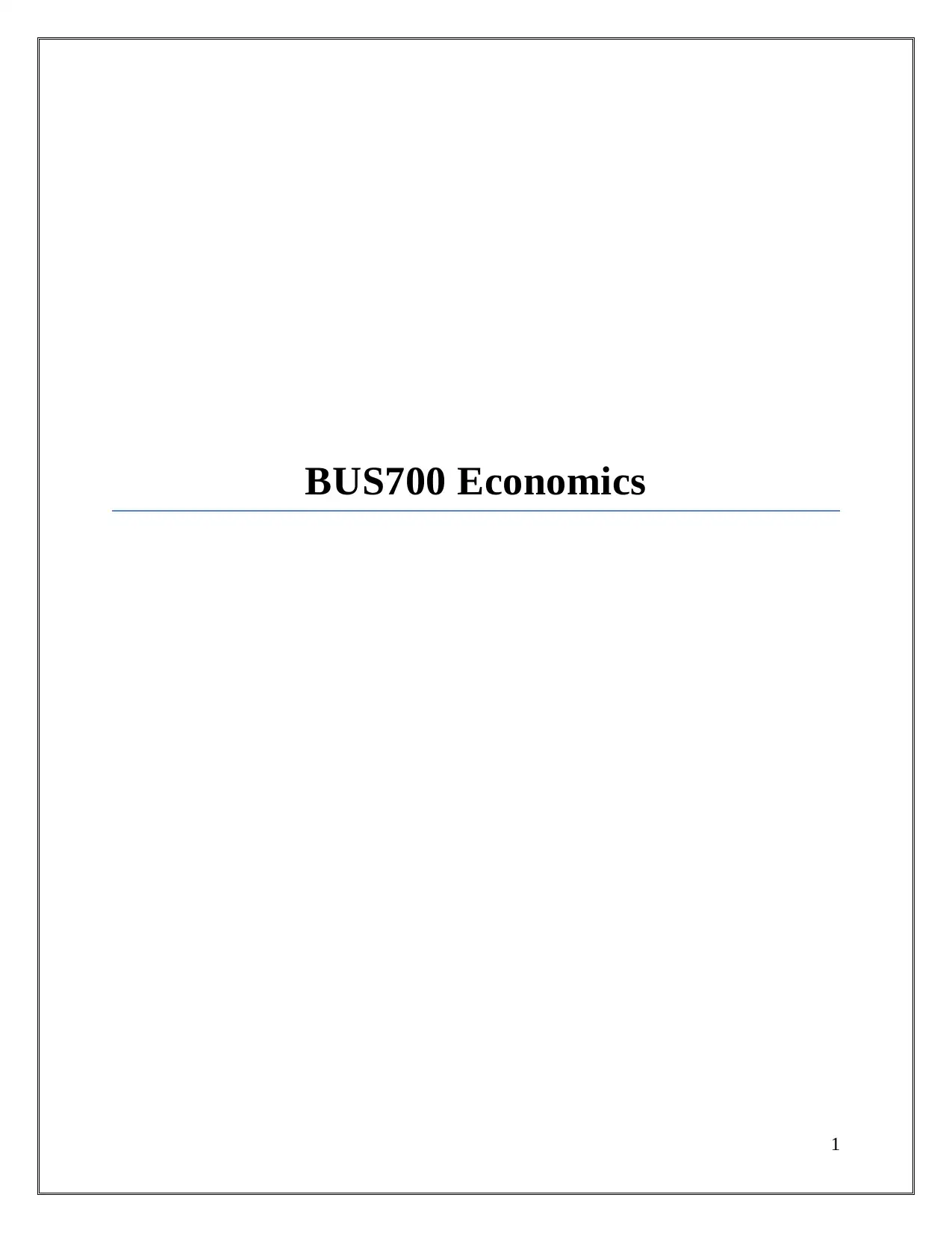
BUS700 Economics
1
1
Paraphrase This Document
Need a fresh take? Get an instant paraphrase of this document with our AI Paraphraser
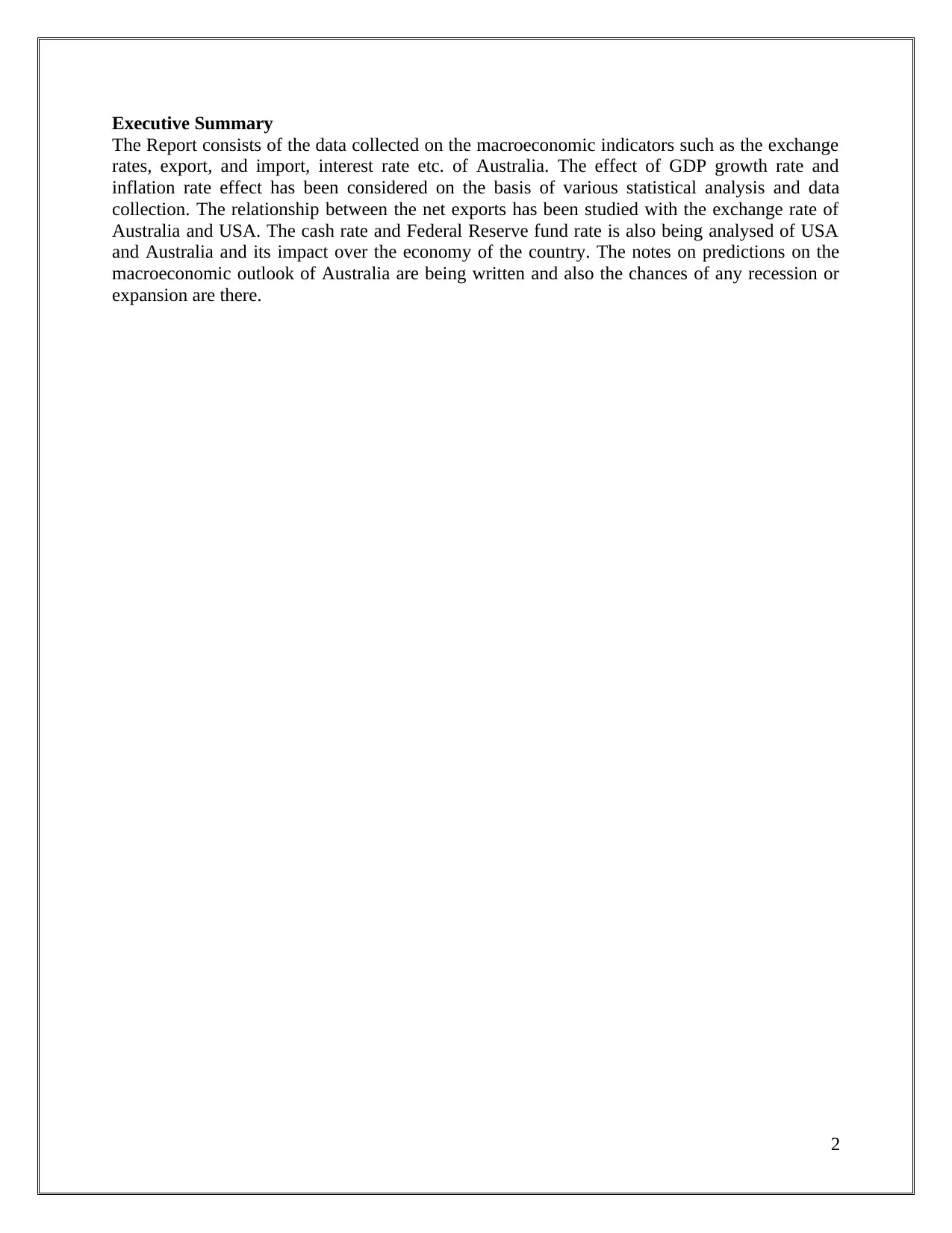
Executive Summary
The Report consists of the data collected on the macroeconomic indicators such as the exchange
rates, export, and import, interest rate etc. of Australia. The effect of GDP growth rate and
inflation rate effect has been considered on the basis of various statistical analysis and data
collection. The relationship between the net exports has been studied with the exchange rate of
Australia and USA. The cash rate and Federal Reserve fund rate is also being analysed of USA
and Australia and its impact over the economy of the country. The notes on predictions on the
macroeconomic outlook of Australia are being written and also the chances of any recession or
expansion are there.
2
The Report consists of the data collected on the macroeconomic indicators such as the exchange
rates, export, and import, interest rate etc. of Australia. The effect of GDP growth rate and
inflation rate effect has been considered on the basis of various statistical analysis and data
collection. The relationship between the net exports has been studied with the exchange rate of
Australia and USA. The cash rate and Federal Reserve fund rate is also being analysed of USA
and Australia and its impact over the economy of the country. The notes on predictions on the
macroeconomic outlook of Australia are being written and also the chances of any recession or
expansion are there.
2
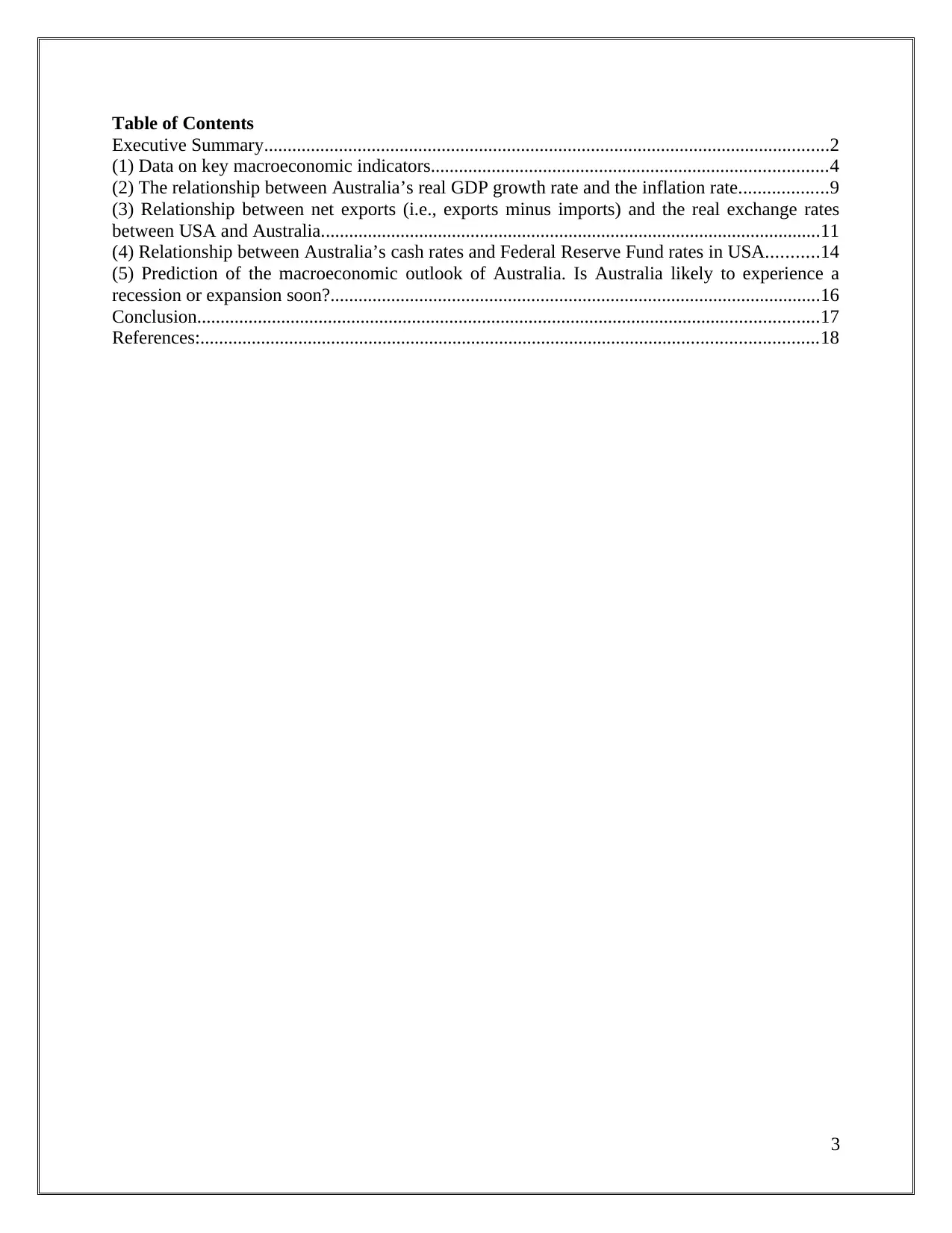
Table of Contents
Executive Summary.........................................................................................................................2
(1) Data on key macroeconomic indicators.....................................................................................4
(2) The relationship between Australia’s real GDP growth rate and the inflation rate...................9
(3) Relationship between net exports (i.e., exports minus imports) and the real exchange rates
between USA and Australia...........................................................................................................11
(4) Relationship between Australia’s cash rates and Federal Reserve Fund rates in USA...........14
(5) Prediction of the macroeconomic outlook of Australia. Is Australia likely to experience a
recession or expansion soon?.........................................................................................................16
Conclusion.....................................................................................................................................17
References:....................................................................................................................................18
3
Executive Summary.........................................................................................................................2
(1) Data on key macroeconomic indicators.....................................................................................4
(2) The relationship between Australia’s real GDP growth rate and the inflation rate...................9
(3) Relationship between net exports (i.e., exports minus imports) and the real exchange rates
between USA and Australia...........................................................................................................11
(4) Relationship between Australia’s cash rates and Federal Reserve Fund rates in USA...........14
(5) Prediction of the macroeconomic outlook of Australia. Is Australia likely to experience a
recession or expansion soon?.........................................................................................................16
Conclusion.....................................................................................................................................17
References:....................................................................................................................................18
3
⊘ This is a preview!⊘
Do you want full access?
Subscribe today to unlock all pages.

Trusted by 1+ million students worldwide
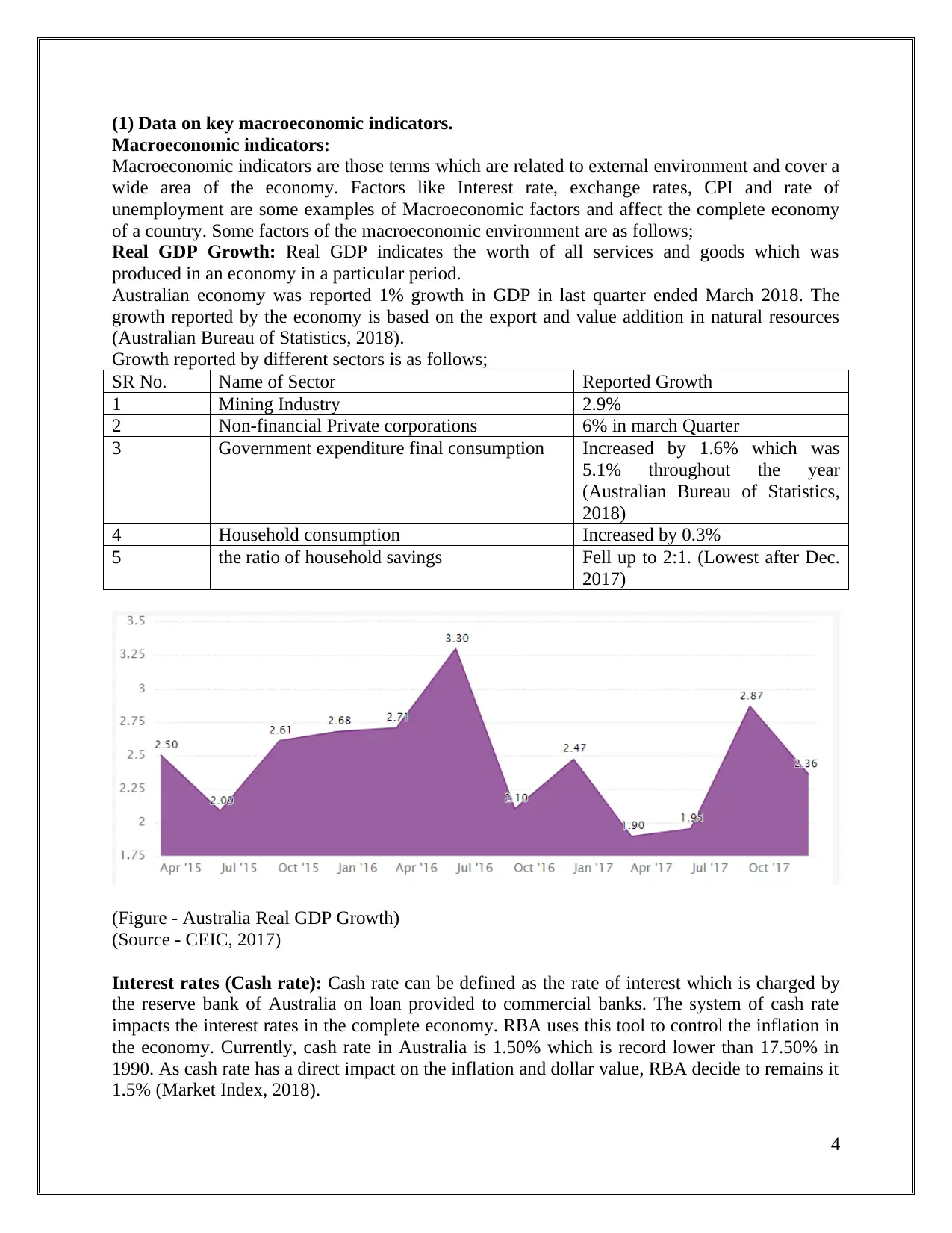
(1) Data on key macroeconomic indicators.
Macroeconomic indicators:
Macroeconomic indicators are those terms which are related to external environment and cover a
wide area of the economy. Factors like Interest rate, exchange rates, CPI and rate of
unemployment are some examples of Macroeconomic factors and affect the complete economy
of a country. Some factors of the macroeconomic environment are as follows;
Real GDP Growth: Real GDP indicates the worth of all services and goods which was
produced in an economy in a particular period.
Australian economy was reported 1% growth in GDP in last quarter ended March 2018. The
growth reported by the economy is based on the export and value addition in natural resources
(Australian Bureau of Statistics, 2018).
Growth reported by different sectors is as follows;
SR No. Name of Sector Reported Growth
1 Mining Industry 2.9%
2 Non-financial Private corporations 6% in march Quarter
3 Government expenditure final consumption Increased by 1.6% which was
5.1% throughout the year
(Australian Bureau of Statistics,
2018)
4 Household consumption Increased by 0.3%
5 the ratio of household savings Fell up to 2:1. (Lowest after Dec.
2017)
(Figure - Australia Real GDP Growth)
(Source - CEIC, 2017)
Interest rates (Cash rate): Cash rate can be defined as the rate of interest which is charged by
the reserve bank of Australia on loan provided to commercial banks. The system of cash rate
impacts the interest rates in the complete economy. RBA uses this tool to control the inflation in
the economy. Currently, cash rate in Australia is 1.50% which is record lower than 17.50% in
1990. As cash rate has a direct impact on the inflation and dollar value, RBA decide to remains it
1.5% (Market Index, 2018).
4
Macroeconomic indicators:
Macroeconomic indicators are those terms which are related to external environment and cover a
wide area of the economy. Factors like Interest rate, exchange rates, CPI and rate of
unemployment are some examples of Macroeconomic factors and affect the complete economy
of a country. Some factors of the macroeconomic environment are as follows;
Real GDP Growth: Real GDP indicates the worth of all services and goods which was
produced in an economy in a particular period.
Australian economy was reported 1% growth in GDP in last quarter ended March 2018. The
growth reported by the economy is based on the export and value addition in natural resources
(Australian Bureau of Statistics, 2018).
Growth reported by different sectors is as follows;
SR No. Name of Sector Reported Growth
1 Mining Industry 2.9%
2 Non-financial Private corporations 6% in march Quarter
3 Government expenditure final consumption Increased by 1.6% which was
5.1% throughout the year
(Australian Bureau of Statistics,
2018)
4 Household consumption Increased by 0.3%
5 the ratio of household savings Fell up to 2:1. (Lowest after Dec.
2017)
(Figure - Australia Real GDP Growth)
(Source - CEIC, 2017)
Interest rates (Cash rate): Cash rate can be defined as the rate of interest which is charged by
the reserve bank of Australia on loan provided to commercial banks. The system of cash rate
impacts the interest rates in the complete economy. RBA uses this tool to control the inflation in
the economy. Currently, cash rate in Australia is 1.50% which is record lower than 17.50% in
1990. As cash rate has a direct impact on the inflation and dollar value, RBA decide to remains it
1.5% (Market Index, 2018).
4
Paraphrase This Document
Need a fresh take? Get an instant paraphrase of this document with our AI Paraphraser
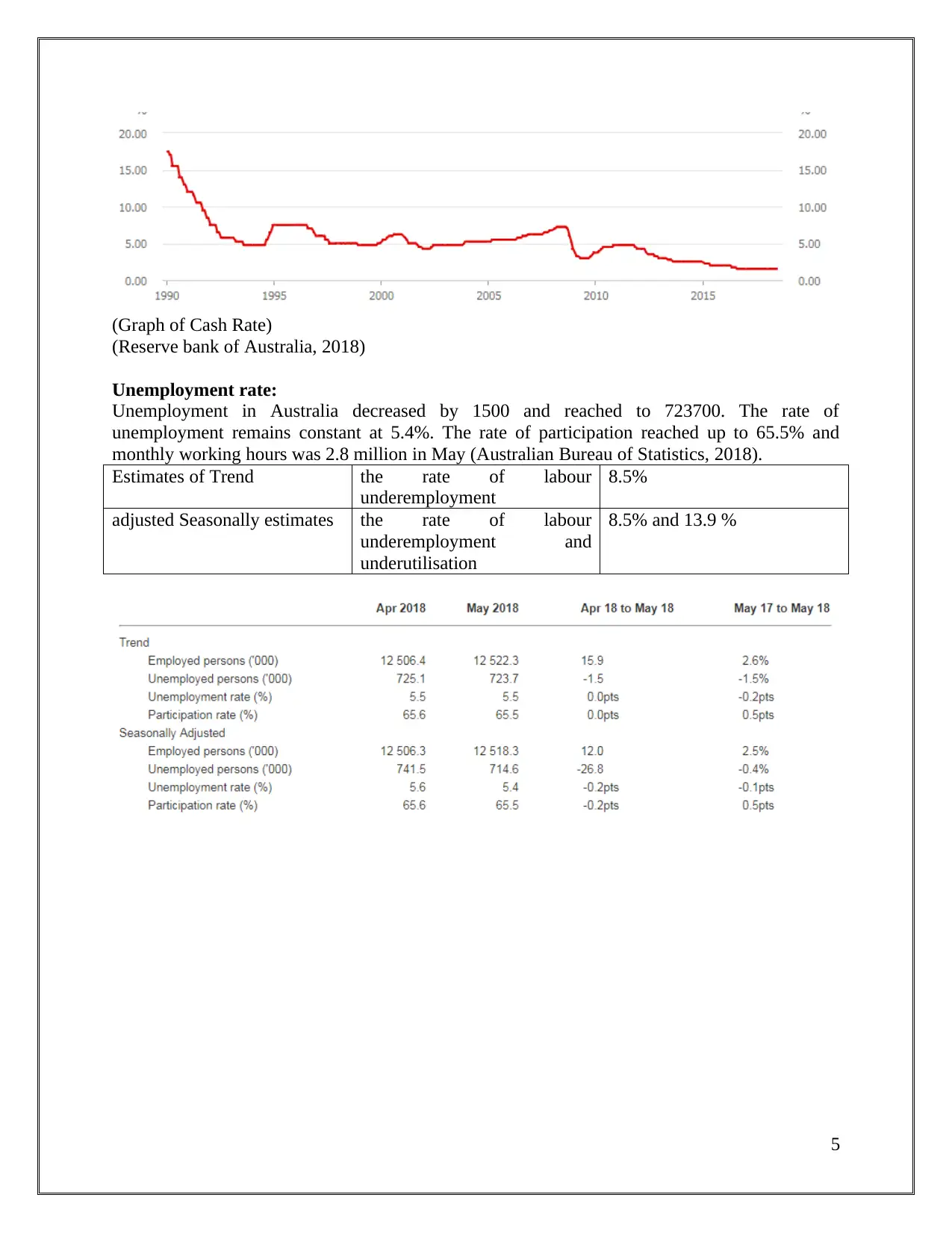
(Graph of Cash Rate)
(Reserve bank of Australia, 2018)
Unemployment rate:
Unemployment in Australia decreased by 1500 and reached to 723700. The rate of
unemployment remains constant at 5.4%. The rate of participation reached up to 65.5% and
monthly working hours was 2.8 million in May (Australian Bureau of Statistics, 2018).
Estimates of Trend the rate of labour
underemployment
8.5%
adjusted Seasonally estimates the rate of labour
underemployment and
underutilisation
8.5% and 13.9 %
5
(Reserve bank of Australia, 2018)
Unemployment rate:
Unemployment in Australia decreased by 1500 and reached to 723700. The rate of
unemployment remains constant at 5.4%. The rate of participation reached up to 65.5% and
monthly working hours was 2.8 million in May (Australian Bureau of Statistics, 2018).
Estimates of Trend the rate of labour
underemployment
8.5%
adjusted Seasonally estimates the rate of labour
underemployment and
underutilisation
8.5% and 13.9 %
5
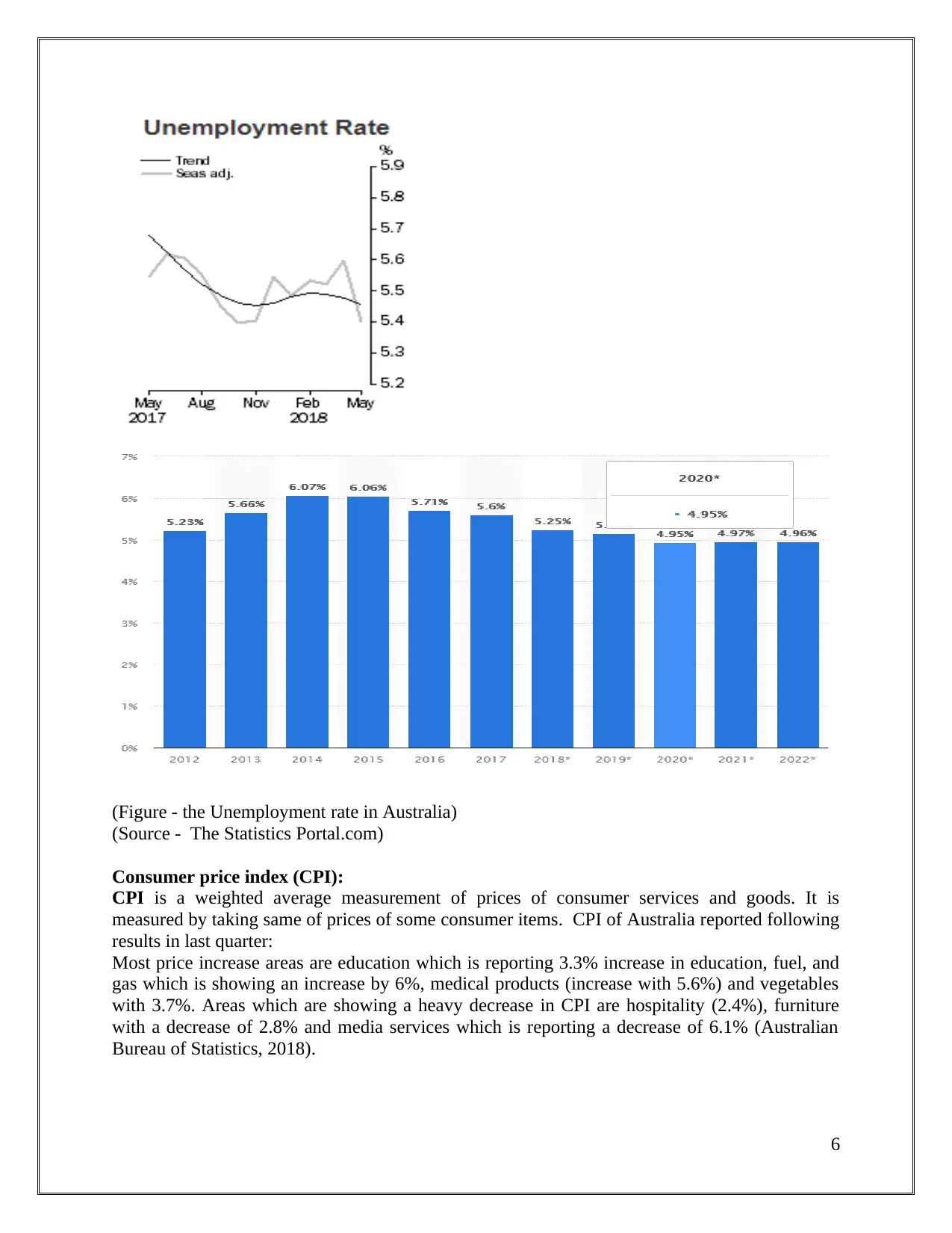
(Figure - the Unemployment rate in Australia)
(Source - The Statistics Portal.com)
Consumer price index (CPI):
CPI is a weighted average measurement of prices of consumer services and goods. It is
measured by taking same of prices of some consumer items. CPI of Australia reported following
results in last quarter:
Most price increase areas are education which is reporting 3.3% increase in education, fuel, and
gas which is showing an increase by 6%, medical products (increase with 5.6%) and vegetables
with 3.7%. Areas which are showing a heavy decrease in CPI are hospitality (2.4%), furniture
with a decrease of 2.8% and media services which is reporting a decrease of 6.1% (Australian
Bureau of Statistics, 2018).
6
(Source - The Statistics Portal.com)
Consumer price index (CPI):
CPI is a weighted average measurement of prices of consumer services and goods. It is
measured by taking same of prices of some consumer items. CPI of Australia reported following
results in last quarter:
Most price increase areas are education which is reporting 3.3% increase in education, fuel, and
gas which is showing an increase by 6%, medical products (increase with 5.6%) and vegetables
with 3.7%. Areas which are showing a heavy decrease in CPI are hospitality (2.4%), furniture
with a decrease of 2.8% and media services which is reporting a decrease of 6.1% (Australian
Bureau of Statistics, 2018).
6
⊘ This is a preview!⊘
Do you want full access?
Subscribe today to unlock all pages.

Trusted by 1+ million students worldwide
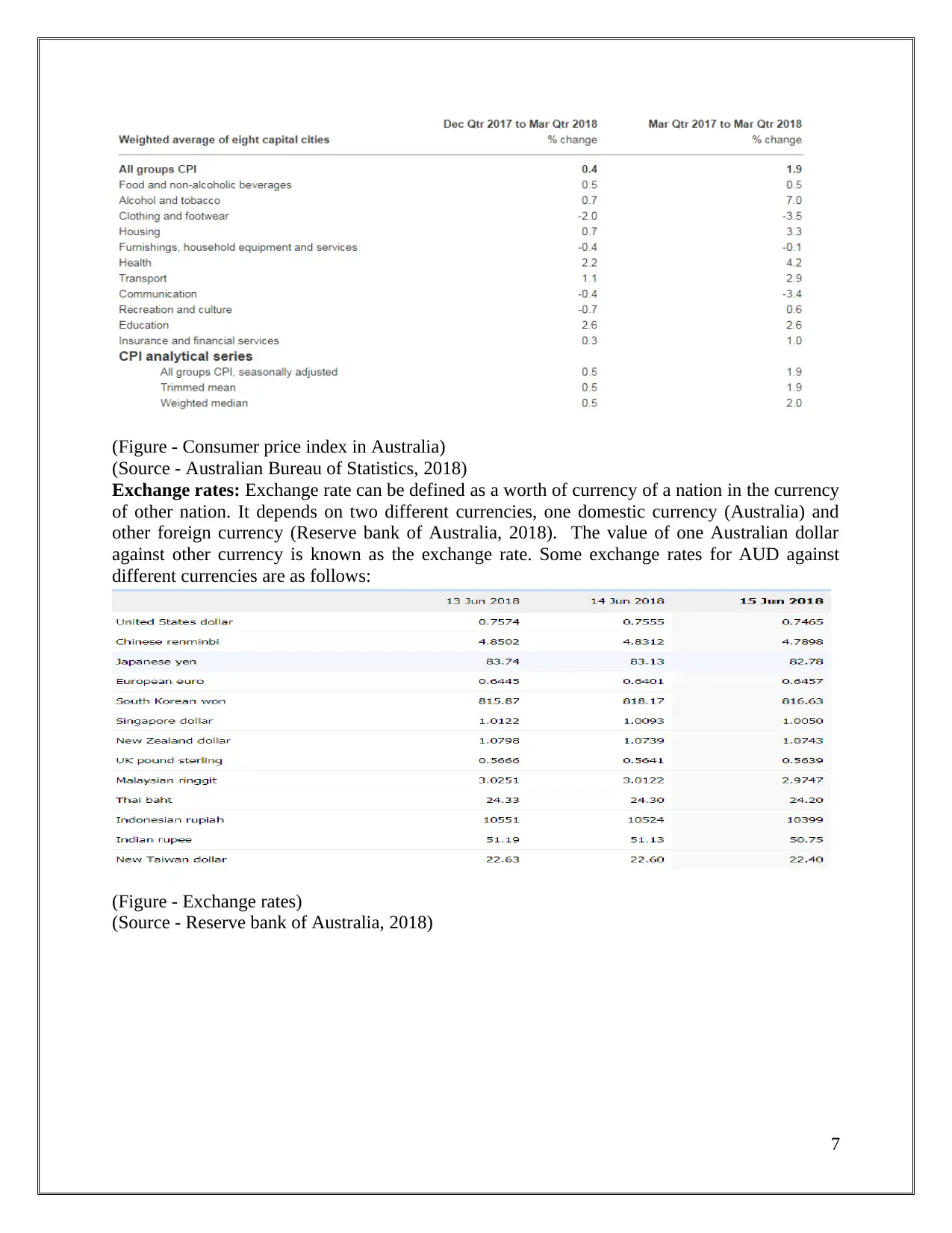
(Figure - Consumer price index in Australia)
(Source - Australian Bureau of Statistics, 2018)
Exchange rates: Exchange rate can be defined as a worth of currency of a nation in the currency
of other nation. It depends on two different currencies, one domestic currency (Australia) and
other foreign currency (Reserve bank of Australia, 2018). The value of one Australian dollar
against other currency is known as the exchange rate. Some exchange rates for AUD against
different currencies are as follows:
(Figure - Exchange rates)
(Source - Reserve bank of Australia, 2018)
7
(Source - Australian Bureau of Statistics, 2018)
Exchange rates: Exchange rate can be defined as a worth of currency of a nation in the currency
of other nation. It depends on two different currencies, one domestic currency (Australia) and
other foreign currency (Reserve bank of Australia, 2018). The value of one Australian dollar
against other currency is known as the exchange rate. Some exchange rates for AUD against
different currencies are as follows:
(Figure - Exchange rates)
(Source - Reserve bank of Australia, 2018)
7
Paraphrase This Document
Need a fresh take? Get an instant paraphrase of this document with our AI Paraphraser
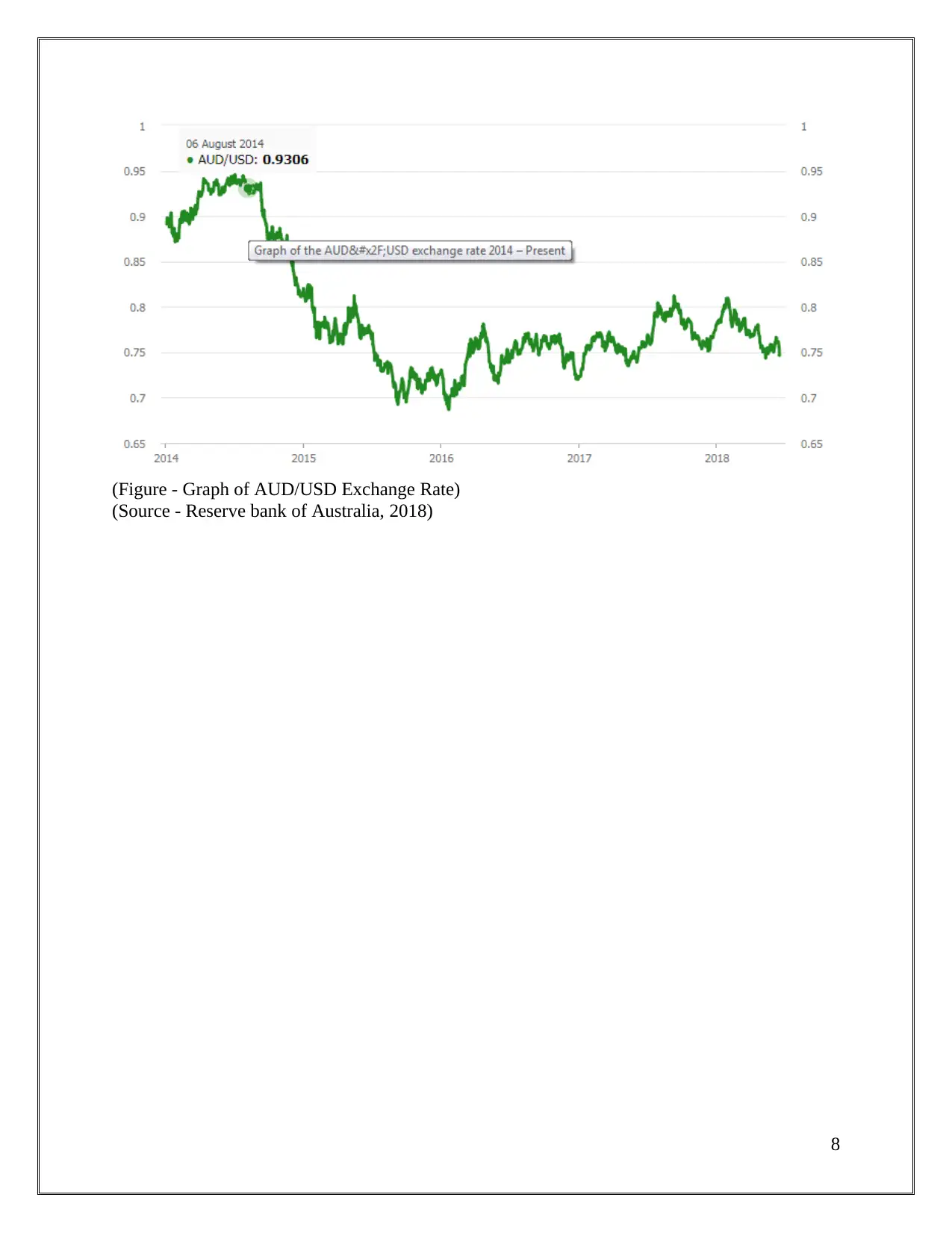
(Figure - Graph of AUD/USD Exchange Rate)
(Source - Reserve bank of Australia, 2018)
8
(Source - Reserve bank of Australia, 2018)
8
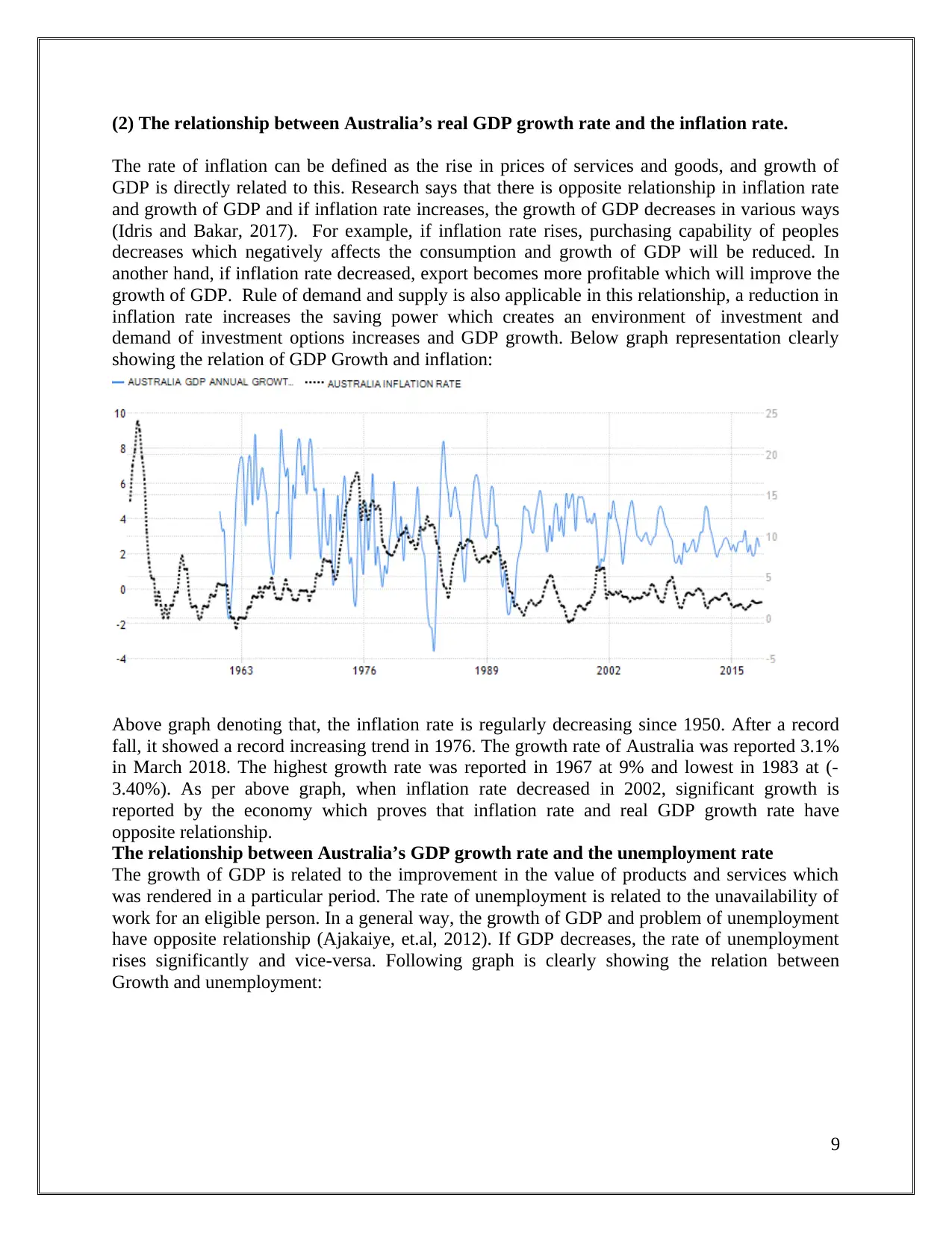
(2) The relationship between Australia’s real GDP growth rate and the inflation rate.
The rate of inflation can be defined as the rise in prices of services and goods, and growth of
GDP is directly related to this. Research says that there is opposite relationship in inflation rate
and growth of GDP and if inflation rate increases, the growth of GDP decreases in various ways
(Idris and Bakar, 2017). For example, if inflation rate rises, purchasing capability of peoples
decreases which negatively affects the consumption and growth of GDP will be reduced. In
another hand, if inflation rate decreased, export becomes more profitable which will improve the
growth of GDP. Rule of demand and supply is also applicable in this relationship, a reduction in
inflation rate increases the saving power which creates an environment of investment and
demand of investment options increases and GDP growth. Below graph representation clearly
showing the relation of GDP Growth and inflation:
Above graph denoting that, the inflation rate is regularly decreasing since 1950. After a record
fall, it showed a record increasing trend in 1976. The growth rate of Australia was reported 3.1%
in March 2018. The highest growth rate was reported in 1967 at 9% and lowest in 1983 at (-
3.40%). As per above graph, when inflation rate decreased in 2002, significant growth is
reported by the economy which proves that inflation rate and real GDP growth rate have
opposite relationship.
The relationship between Australia’s GDP growth rate and the unemployment rate
The growth of GDP is related to the improvement in the value of products and services which
was rendered in a particular period. The rate of unemployment is related to the unavailability of
work for an eligible person. In a general way, the growth of GDP and problem of unemployment
have opposite relationship (Ajakaiye, et.al, 2012). If GDP decreases, the rate of unemployment
rises significantly and vice-versa. Following graph is clearly showing the relation between
Growth and unemployment:
9
The rate of inflation can be defined as the rise in prices of services and goods, and growth of
GDP is directly related to this. Research says that there is opposite relationship in inflation rate
and growth of GDP and if inflation rate increases, the growth of GDP decreases in various ways
(Idris and Bakar, 2017). For example, if inflation rate rises, purchasing capability of peoples
decreases which negatively affects the consumption and growth of GDP will be reduced. In
another hand, if inflation rate decreased, export becomes more profitable which will improve the
growth of GDP. Rule of demand and supply is also applicable in this relationship, a reduction in
inflation rate increases the saving power which creates an environment of investment and
demand of investment options increases and GDP growth. Below graph representation clearly
showing the relation of GDP Growth and inflation:
Above graph denoting that, the inflation rate is regularly decreasing since 1950. After a record
fall, it showed a record increasing trend in 1976. The growth rate of Australia was reported 3.1%
in March 2018. The highest growth rate was reported in 1967 at 9% and lowest in 1983 at (-
3.40%). As per above graph, when inflation rate decreased in 2002, significant growth is
reported by the economy which proves that inflation rate and real GDP growth rate have
opposite relationship.
The relationship between Australia’s GDP growth rate and the unemployment rate
The growth of GDP is related to the improvement in the value of products and services which
was rendered in a particular period. The rate of unemployment is related to the unavailability of
work for an eligible person. In a general way, the growth of GDP and problem of unemployment
have opposite relationship (Ajakaiye, et.al, 2012). If GDP decreases, the rate of unemployment
rises significantly and vice-versa. Following graph is clearly showing the relation between
Growth and unemployment:
9
⊘ This is a preview!⊘
Do you want full access?
Subscribe today to unlock all pages.

Trusted by 1+ million students worldwide
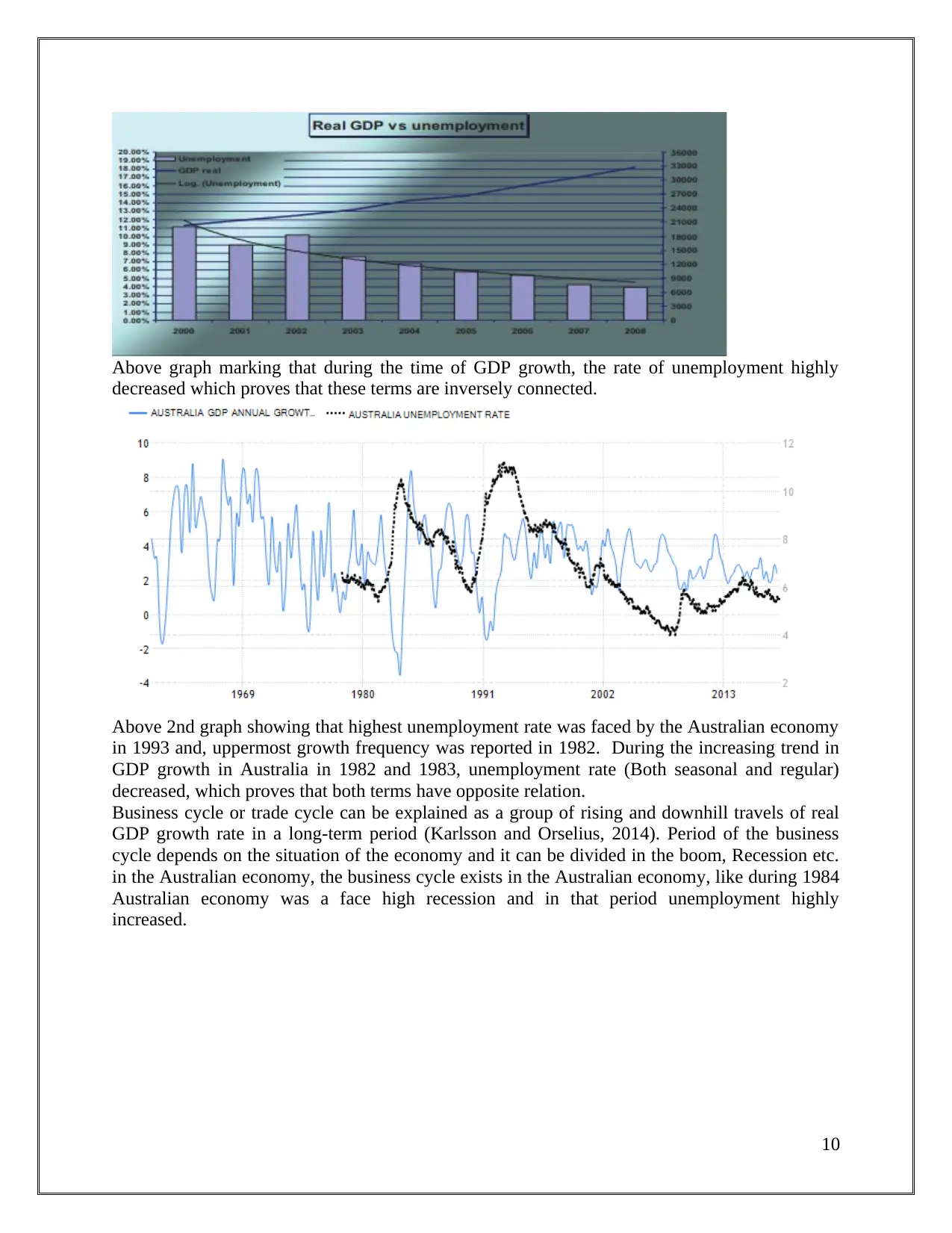
Above graph marking that during the time of GDP growth, the rate of unemployment highly
decreased which proves that these terms are inversely connected.
Above 2nd graph showing that highest unemployment rate was faced by the Australian economy
in 1993 and, uppermost growth frequency was reported in 1982. During the increasing trend in
GDP growth in Australia in 1982 and 1983, unemployment rate (Both seasonal and regular)
decreased, which proves that both terms have opposite relation.
Business cycle or trade cycle can be explained as a group of rising and downhill travels of real
GDP growth rate in a long-term period (Karlsson and Orselius, 2014). Period of the business
cycle depends on the situation of the economy and it can be divided in the boom, Recession etc.
in the Australian economy, the business cycle exists in the Australian economy, like during 1984
Australian economy was a face high recession and in that period unemployment highly
increased.
10
decreased which proves that these terms are inversely connected.
Above 2nd graph showing that highest unemployment rate was faced by the Australian economy
in 1993 and, uppermost growth frequency was reported in 1982. During the increasing trend in
GDP growth in Australia in 1982 and 1983, unemployment rate (Both seasonal and regular)
decreased, which proves that both terms have opposite relation.
Business cycle or trade cycle can be explained as a group of rising and downhill travels of real
GDP growth rate in a long-term period (Karlsson and Orselius, 2014). Period of the business
cycle depends on the situation of the economy and it can be divided in the boom, Recession etc.
in the Australian economy, the business cycle exists in the Australian economy, like during 1984
Australian economy was a face high recession and in that period unemployment highly
increased.
10
Paraphrase This Document
Need a fresh take? Get an instant paraphrase of this document with our AI Paraphraser
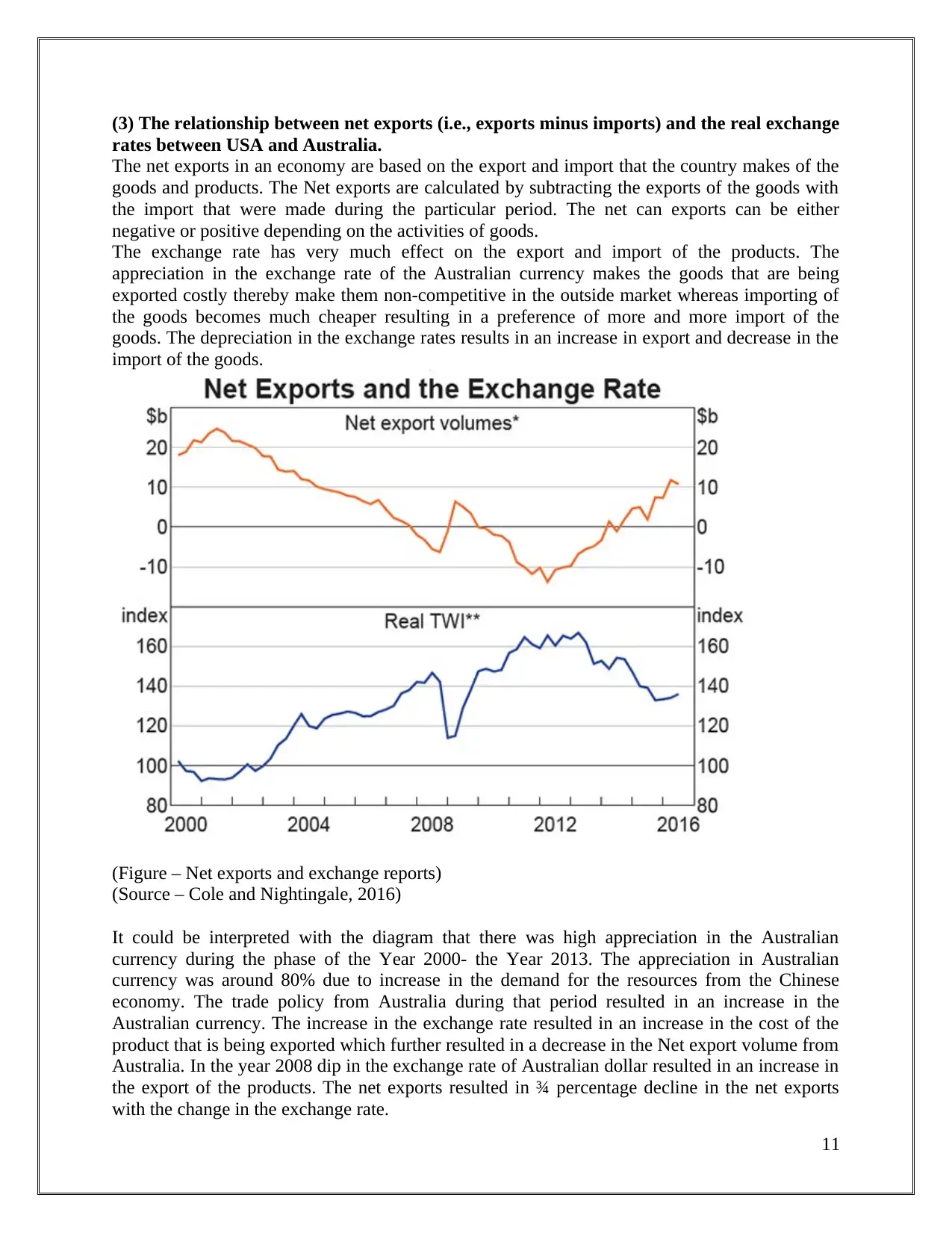
(3) The relationship between net exports (i.e., exports minus imports) and the real exchange
rates between USA and Australia.
The net exports in an economy are based on the export and import that the country makes of the
goods and products. The Net exports are calculated by subtracting the exports of the goods with
the import that were made during the particular period. The net can exports can be either
negative or positive depending on the activities of goods.
The exchange rate has very much effect on the export and import of the products. The
appreciation in the exchange rate of the Australian currency makes the goods that are being
exported costly thereby make them non-competitive in the outside market whereas importing of
the goods becomes much cheaper resulting in a preference of more and more import of the
goods. The depreciation in the exchange rates results in an increase in export and decrease in the
import of the goods.
(Figure – Net exports and exchange reports)
(Source – Cole and Nightingale, 2016)
It could be interpreted with the diagram that there was high appreciation in the Australian
currency during the phase of the Year 2000- the Year 2013. The appreciation in Australian
currency was around 80% due to increase in the demand for the resources from the Chinese
economy. The trade policy from Australia during that period resulted in an increase in the
Australian currency. The increase in the exchange rate resulted in an increase in the cost of the
product that is being exported which further resulted in a decrease in the Net export volume from
Australia. In the year 2008 dip in the exchange rate of Australian dollar resulted in an increase in
the export of the products. The net exports resulted in ¾ percentage decline in the net exports
with the change in the exchange rate.
11
rates between USA and Australia.
The net exports in an economy are based on the export and import that the country makes of the
goods and products. The Net exports are calculated by subtracting the exports of the goods with
the import that were made during the particular period. The net can exports can be either
negative or positive depending on the activities of goods.
The exchange rate has very much effect on the export and import of the products. The
appreciation in the exchange rate of the Australian currency makes the goods that are being
exported costly thereby make them non-competitive in the outside market whereas importing of
the goods becomes much cheaper resulting in a preference of more and more import of the
goods. The depreciation in the exchange rates results in an increase in export and decrease in the
import of the goods.
(Figure – Net exports and exchange reports)
(Source – Cole and Nightingale, 2016)
It could be interpreted with the diagram that there was high appreciation in the Australian
currency during the phase of the Year 2000- the Year 2013. The appreciation in Australian
currency was around 80% due to increase in the demand for the resources from the Chinese
economy. The trade policy from Australia during that period resulted in an increase in the
Australian currency. The increase in the exchange rate resulted in an increase in the cost of the
product that is being exported which further resulted in a decrease in the Net export volume from
Australia. In the year 2008 dip in the exchange rate of Australian dollar resulted in an increase in
the export of the products. The net exports resulted in ¾ percentage decline in the net exports
with the change in the exchange rate.
11
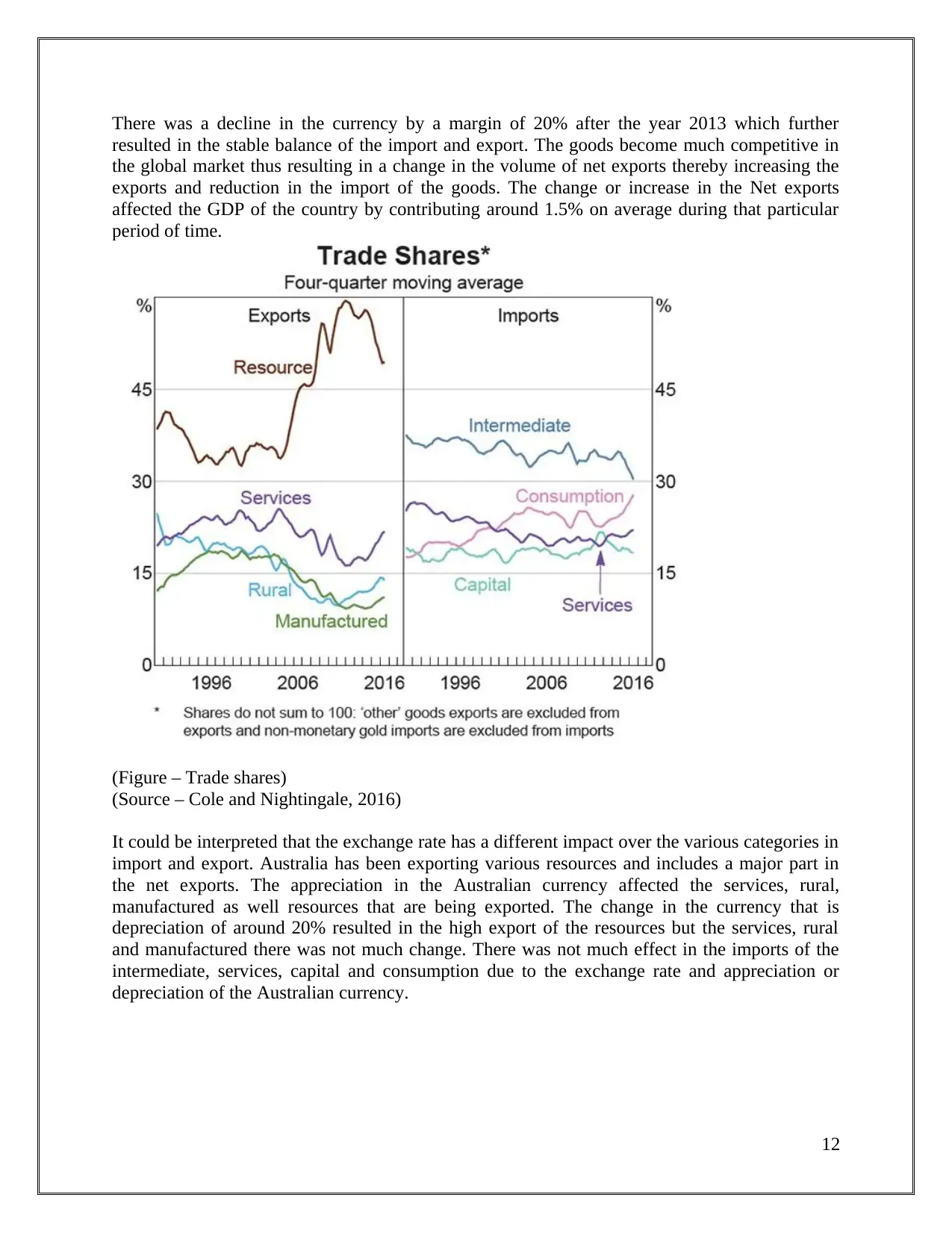
There was a decline in the currency by a margin of 20% after the year 2013 which further
resulted in the stable balance of the import and export. The goods become much competitive in
the global market thus resulting in a change in the volume of net exports thereby increasing the
exports and reduction in the import of the goods. The change or increase in the Net exports
affected the GDP of the country by contributing around 1.5% on average during that particular
period of time.
(Figure – Trade shares)
(Source – Cole and Nightingale, 2016)
It could be interpreted that the exchange rate has a different impact over the various categories in
import and export. Australia has been exporting various resources and includes a major part in
the net exports. The appreciation in the Australian currency affected the services, rural,
manufactured as well resources that are being exported. The change in the currency that is
depreciation of around 20% resulted in the high export of the resources but the services, rural
and manufactured there was not much change. There was not much effect in the imports of the
intermediate, services, capital and consumption due to the exchange rate and appreciation or
depreciation of the Australian currency.
12
resulted in the stable balance of the import and export. The goods become much competitive in
the global market thus resulting in a change in the volume of net exports thereby increasing the
exports and reduction in the import of the goods. The change or increase in the Net exports
affected the GDP of the country by contributing around 1.5% on average during that particular
period of time.
(Figure – Trade shares)
(Source – Cole and Nightingale, 2016)
It could be interpreted that the exchange rate has a different impact over the various categories in
import and export. Australia has been exporting various resources and includes a major part in
the net exports. The appreciation in the Australian currency affected the services, rural,
manufactured as well resources that are being exported. The change in the currency that is
depreciation of around 20% resulted in the high export of the resources but the services, rural
and manufactured there was not much change. There was not much effect in the imports of the
intermediate, services, capital and consumption due to the exchange rate and appreciation or
depreciation of the Australian currency.
12
⊘ This is a preview!⊘
Do you want full access?
Subscribe today to unlock all pages.

Trusted by 1+ million students worldwide
1 out of 19
Related Documents
Your All-in-One AI-Powered Toolkit for Academic Success.
+13062052269
info@desklib.com
Available 24*7 on WhatsApp / Email
![[object Object]](/_next/static/media/star-bottom.7253800d.svg)
Unlock your academic potential
Copyright © 2020–2025 A2Z Services. All Rights Reserved. Developed and managed by ZUCOL.





